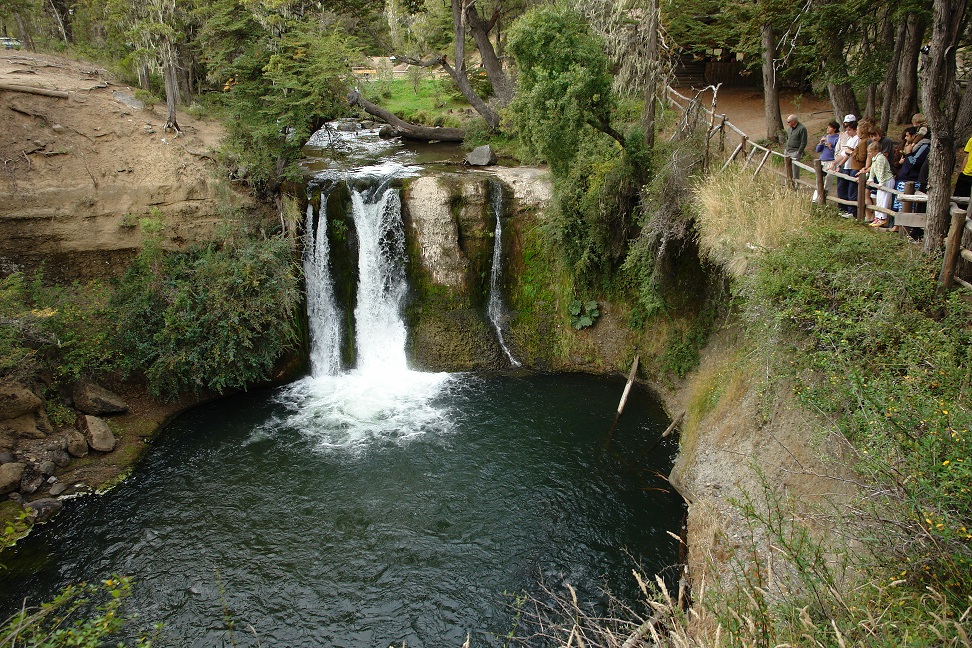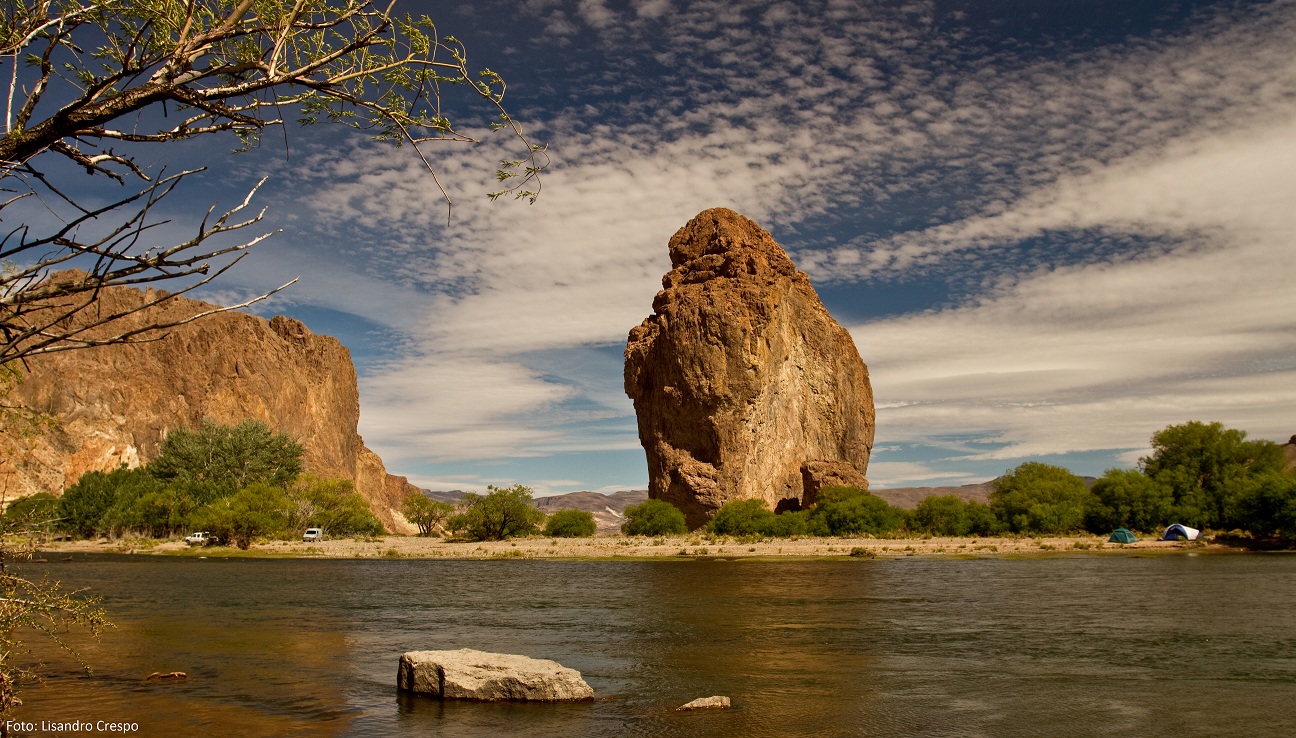This is a journey from west to east, crossing the Chubut Province in width. From the mountain range to the valley, you will see five hundred kilometers that surprise visitors by the variety of their landscapes, by the cultural proposals that are paired with wines and good gastronomy, and places that open the door to the past, finding traces that were left by ancient civilizations, landscapes eroded by the time and unique findings about the giants that inhabited these soils millions of years ago.
The suggested circuit takes approximately five days, starting in the city of Esquel, which has the possibility of arriving by air or land. Barely 25 kms separate this city from Trevelin, a small town where the Welsh settled at the end of the 19th century, and it is proposed to spend the first night there. On the way there are two stops to get to know the “Sierra Colorada” area where outdoor activities are combined with the Mapuche culture, and the Rosario Lake, a place that keeps the history of the original peoples alive. At the end of the afternoon, an approach to Welsh culture through its gastronomy cannot be missed. The tradition of Welsh tea summarizes a fundamental moment in the life of the Welsh communities of Chubut, and today it is enjoyed in the tea houses through these succulent and delicious snacks that include, in addition to the aforementioned infusion, the famous “Welsh” cake, scons, homemade breads and butter, among other delicacies.
 The next day, again on the way to Esquel, endless attractions await on the side of Route 259. First, an unmissable encounter with nature in the Nant and Fall Waterfalls Protected Natural Area, where you can contemplate the beautiful waterfalls that make the river, from walkways and viewpoints in a magical environment of the Andean Patagonian Forest. This area is also characterized by having the southernmost vineyards in the world, a true Patagonian treasure. “Viñas del Nant y Fall” is a productive establishment where it is possible to take guided tours of the vineyard that has more than 6000 plants of Pinot Noir and other cold weather varieties. If you are lucky enough to make this trip in the month of October, there is a plus in the itinerary that gives away the best postcards of the route. We refer to the tulip fields in bloom and your gaze is lost in that carpet of bright and explosive colors, guarded by an imposing mountain range. Thanks to the fact we live in the era of digital photography, there is no limit to capture this view.
The next day, again on the way to Esquel, endless attractions await on the side of Route 259. First, an unmissable encounter with nature in the Nant and Fall Waterfalls Protected Natural Area, where you can contemplate the beautiful waterfalls that make the river, from walkways and viewpoints in a magical environment of the Andean Patagonian Forest. This area is also characterized by having the southernmost vineyards in the world, a true Patagonian treasure. “Viñas del Nant y Fall” is a productive establishment where it is possible to take guided tours of the vineyard that has more than 6000 plants of Pinot Noir and other cold weather varieties. If you are lucky enough to make this trip in the month of October, there is a plus in the itinerary that gives away the best postcards of the route. We refer to the tulip fields in bloom and your gaze is lost in that carpet of bright and explosive colors, guarded by an imposing mountain range. Thanks to the fact we live in the era of digital photography, there is no limit to capture this view.
 But there is much more to visit in these few kilometers. The Nant y Fach Flour Mill Museum, witness to a wheat era, built in the likeness of the old mills, reflecting the customs and habits of the past, is one of them. Lovers of gastronomy will find plenty of reasons to thoroughly explore every inch of this area to discover, for example, the “Arroyo Bagillt” Fish Farming Station, which is in charge of keeping the population of Trouts and Salmons stable in all the water courses of the Chubut River. The visitor can see different pools and know the laboratories on business days. Continuing with this theme, you can visit the Jordán Establishment, which is dedicated to trout farming and production of smoked products. The pairing of these delicacies can be found at “Casa Yagüe”, southern wines, where the visit consists of a tour along the vineyards with unique landscapes, to later visit the winery and share some wine tasting. In the area of the quiet place “Los Cipreses”, you can visit agritourism farms such as “Caricias del Bosque”, and very close to it, you can visit “Legua 13 Frutillas Orgánicas”, a family business that combines the production of fine fruits with tourist proposals.
But there is much more to visit in these few kilometers. The Nant y Fach Flour Mill Museum, witness to a wheat era, built in the likeness of the old mills, reflecting the customs and habits of the past, is one of them. Lovers of gastronomy will find plenty of reasons to thoroughly explore every inch of this area to discover, for example, the “Arroyo Bagillt” Fish Farming Station, which is in charge of keeping the population of Trouts and Salmons stable in all the water courses of the Chubut River. The visitor can see different pools and know the laboratories on business days. Continuing with this theme, you can visit the Jordán Establishment, which is dedicated to trout farming and production of smoked products. The pairing of these delicacies can be found at “Casa Yagüe”, southern wines, where the visit consists of a tour along the vineyards with unique landscapes, to later visit the winery and share some wine tasting. In the area of the quiet place “Los Cipreses”, you can visit agritourism farms such as “Caricias del Bosque”, and very close to it, you can visit “Legua 13 Frutillas Orgánicas”, a family business that combines the production of fine fruits with tourist proposals.
After this short but varied journey, you will arrive to the city of Esquel for dinner and rest, and the next day you will start a journey of 80 kms. to Gualjaina. The landscape changes and enters the Patagonian steppe, which offers a unique charm. After a tour through this picturesque town, it is suggested to visit the “Hostería Huancache”, where it is possible to have lunch and get to know its artisanal and organic vineyard. 20 minutes from there is the “Piedra Parada” Protected Natural Area, where an imposing stone of volcanic origin stands 210 meters high. The place was the caldera of an ancient volcano, the chimney of which solidified and gave rise to very peculiar geoforms. The old walls with traces of the incandescent material also treasure cave paintings left by the ancient populations of the area. Adjacent to this place, we find the entrance to the “Cañadón de la Buitrera”, a particular geological formation with walls that exceed 200 meters in height. There is no visitor who is not astonished by these incredible rock formations that house ancient engravings, cave paintings and fossils, testimonies of ancient civilizations and the irrefutable proof of the millions of years that left their mark on the Patagonian geography. This place is also of interest to bird watchers and fans of climbing and rappelling.

Continuing the road, a stop in Paso del Sapo is well-worth, a small town with a young wine-growing activity, where the “Estancia Los Robles – Rincón de los Leones” vineyards stand out, producing excellent quality Chardonnay strains. From there the next destination is “Los Altares” for dinner and to spend the night.
On this day, the proposal is to make the 280 kms that remain to reach the city of Trelew on Route 25, visiting on the way unique places for their beauty which are far from what we traditionally see in classic Patagonian postcards. This is the case of “Los Altares”, that gives us a cinematographic setting, with its immense cliffs, walls carved by climatic effects and the passage of centuries that capriciously form figures that resemble altars, hence its name. Deep canyons and cliffs complete the image, which at times acquires reddish tones due to sunlight. In the area you can also do agritourism and continue learning about the innovative wine production of Chubut.
Advancing through the Patagonian steppe, you reach the small town of “Las Plumas”, where there are important deposits of rock stones and petrified trees. And a few kilometers away, the “Florentino Ameghino” Dam, which originated from the construction of the hydroelectric power plant, is the ideal place to visit in summer, where you can do recreational activities, trout fishing and adventure proposals such as rafting, trekking, rappelling, zip-lining and climbing, among other activities.

Trelew will be the last step of this circuit. From there it is suggested to visit the localities of the lower valley of the Chubut River, with a strong Welsh imprint, on a journey that allows you to explore the spirit of the pioneers who came to this land, learn about their history, their traditions and the way they live today, also enjoying a lush green landscape and the slow pace of these towns.
Another point of interest is the Astronomical Center, where tour guides are held in the Planetarium room and the theme park, you can attend projections in the dome and make night observations, in a fascinating approach to astrotourism.
Before heading back, you cannot miss an appointment with prehistory at the Paleontological Museum Egidio Feruglio of Trelew, a center for scientific activities and exhibitions, with interpretive tours that tell the story of the life forms that populated Patagonia through a time travel of millions of years into the past. But without a doubt, the grand finale of this trip is the possibility of meeting the largest dinosaur in the world, the Patagotitan Mayorum, whose bones have been recently found in the area in an excellent state of preservation, becoming one of the most relevant paleontological discoveries.
After this adventure through the less explored sites of this Chubut circuit, we suggest taking advantage of the stay to make the classic wildlife sightings that are offered in the area. Depending on the time of year, you can go to “Punta Tombo” to see the largest continental colony of Magellanic Penguins in the world, or go to “Peninsula Valdés” to see specimens of southern right whales, which stop at these things between the months of June and December.
